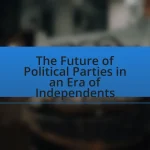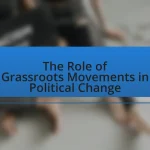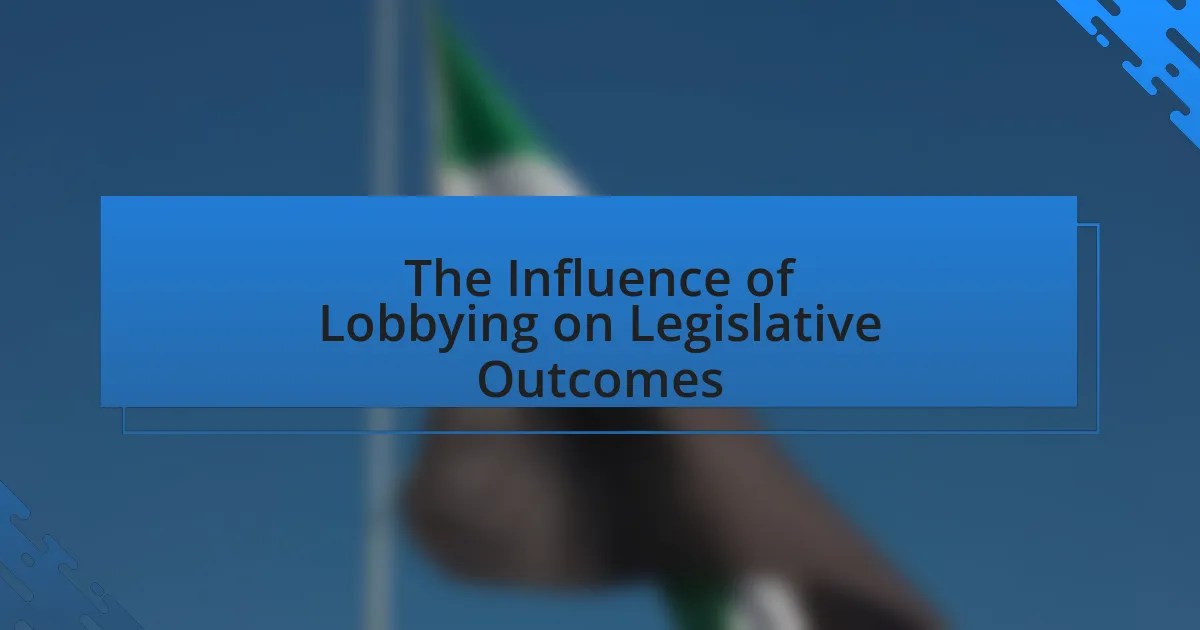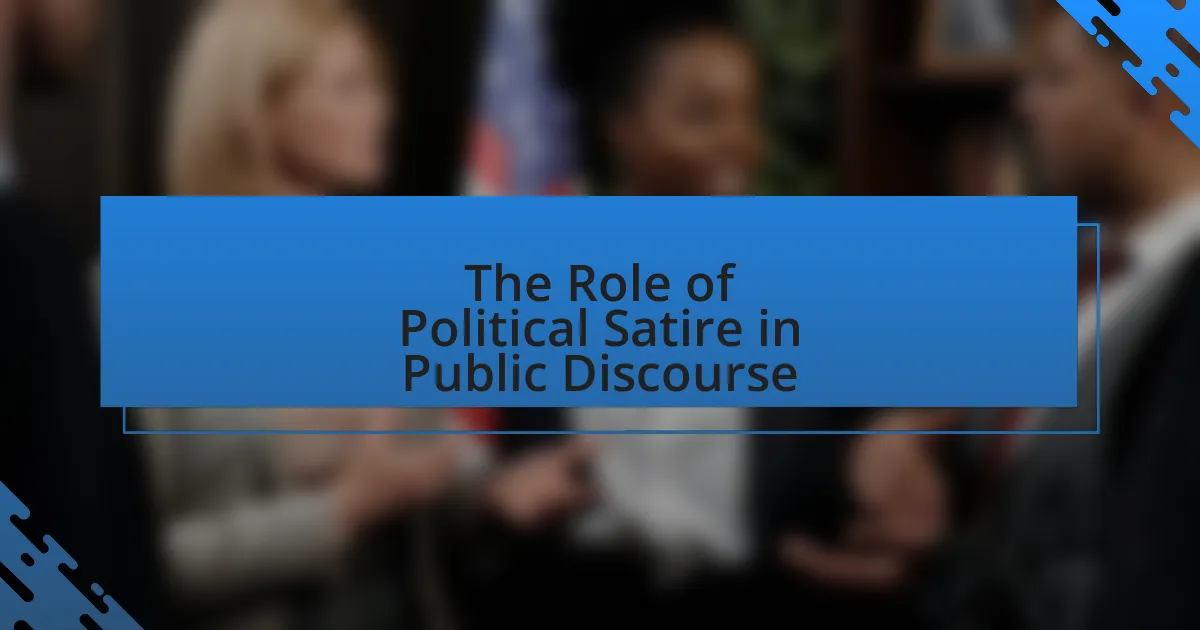The article analyzes the political ramifications of immigration policy changes, highlighting their significant impact on voter demographics, party alignments, and public opinion. It discusses how shifts in immigration policies can mobilize communities, influence electoral outcomes, and reshape party dynamics, as evidenced by historical events and recent elections. Additionally, the article examines the role of public sentiment in shaping immigration legislation, the implications for various stakeholders, and the challenges faced by law enforcement. It concludes by exploring future trends in immigration policy and best practices for effective reform, emphasizing the importance of stakeholder engagement and data-driven approaches.
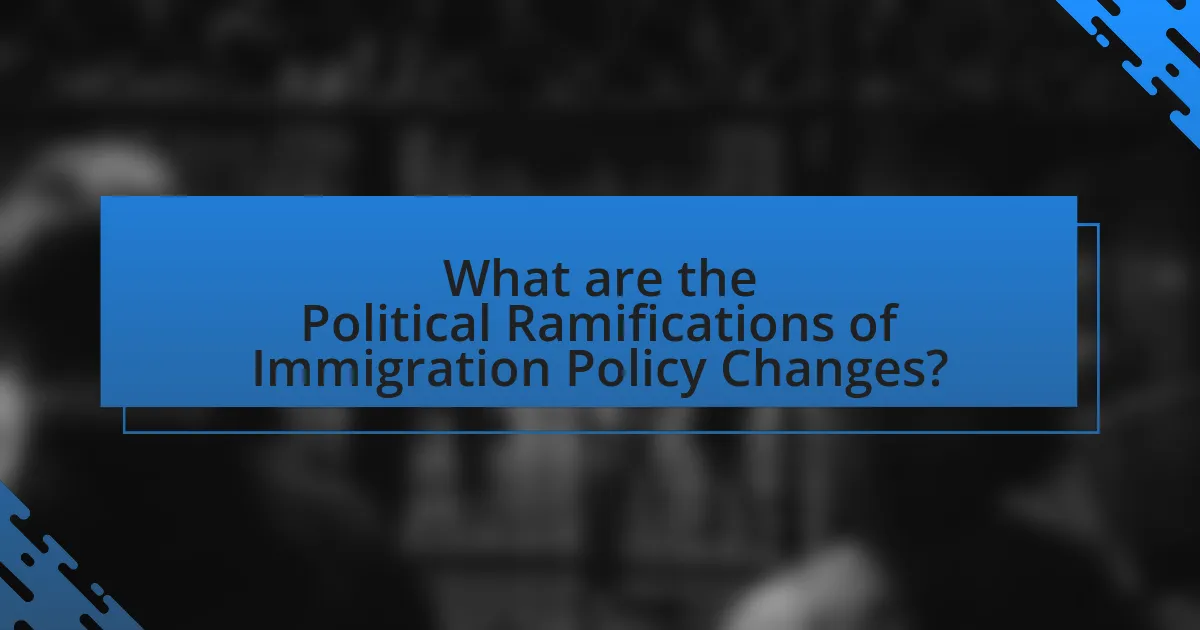
What are the Political Ramifications of Immigration Policy Changes?
Immigration policy changes can significantly impact political landscapes by influencing voter demographics, party alignments, and public opinion. For instance, stricter immigration policies may mobilize immigrant communities and their allies to advocate for more inclusive policies, potentially shifting electoral outcomes in favor of parties that support immigration reform. Conversely, more lenient policies can lead to backlash from segments of the population that perceive these changes as threats to job security or cultural identity, thereby strengthening anti-immigration sentiments within certain political factions. Historical evidence shows that immigration policy shifts, such as the 1986 Immigration Reform and Control Act, have led to substantial changes in voter behavior and party strategies, illustrating the profound political ramifications of such policies.
How do immigration policy changes impact national politics?
Immigration policy changes significantly impact national politics by influencing voter sentiment, party alignment, and legislative agendas. For instance, shifts towards more restrictive immigration policies can galvanize support for nationalist and populist movements, as seen in the United States during the 2016 presidential election, where immigration became a central issue. Additionally, changes in immigration policy can lead to realignments within political parties, as moderate members may face pressure from more extreme factions, affecting overall party cohesion. Historical data shows that immigration policy debates often dominate political discourse, shaping election outcomes and legislative priorities, thereby illustrating the profound connection between immigration policy and national political dynamics.
What are the immediate political effects of immigration policy changes?
Immediate political effects of immigration policy changes include shifts in voter sentiment, alterations in party alignment, and changes in legislative priorities. For instance, when a government enacts stricter immigration policies, it can lead to increased support for opposition parties that advocate for more inclusive policies, as seen in the 2016 U.S. presidential election where immigration became a pivotal issue. Additionally, such changes can prompt immediate responses from advocacy groups, influencing public discourse and mobilizing grassroots campaigns. Historical data shows that immigration policy shifts often correlate with fluctuations in public opinion polls, reflecting the electorate’s concerns about economic and social impacts.
How do these changes influence political party dynamics?
Changes in immigration policy significantly influence political party dynamics by reshaping voter demographics and party platforms. For instance, more inclusive immigration policies can attract younger, diverse voters who prioritize social justice, thereby pushing parties to adopt more progressive stances. Conversely, restrictive immigration policies may galvanize support among conservative voters who prioritize national security, leading parties to adopt more hardline positions. Historical data from the 2016 U.S. presidential election illustrates this shift, where the Republican Party’s focus on immigration enforcement resonated with a significant portion of its base, while the Democratic Party’s advocacy for comprehensive immigration reform aimed to mobilize minority voters. These dynamics illustrate how immigration policy changes can realign party ideologies and voter coalitions, ultimately affecting electoral outcomes.
What role do public opinions play in shaping immigration policies?
Public opinions significantly influence the formulation and adjustment of immigration policies. Policymakers often consider public sentiment to gauge support or opposition to immigration measures, as demonstrated by various surveys indicating that public attitudes can sway legislative decisions. For instance, a Pew Research Center study found that shifts in public opinion regarding immigration can lead to changes in policy, such as the implementation of stricter border controls or pathways to citizenship. This correlation underscores the importance of public perceptions in shaping the political landscape surrounding immigration.
How does public sentiment affect legislative decisions on immigration?
Public sentiment significantly influences legislative decisions on immigration by shaping policymakers’ priorities and actions. When a majority of the public expresses strong opinions on immigration, whether in favor or against, legislators often respond to these sentiments to align with their constituents’ views and secure electoral support. For instance, surveys conducted by the Pew Research Center indicate that public opinion on immigration can sway legislative outcomes, as seen in the debates surrounding the Deferred Action for Childhood Arrivals (DACA) program, where widespread public support for Dreamers prompted lawmakers to consider protective measures. Additionally, during election cycles, candidates frequently adjust their immigration policies based on prevailing public attitudes, demonstrating the direct correlation between public sentiment and legislative behavior.
What are the implications of public opinion shifts on future policies?
Public opinion shifts significantly influence future policies by altering the political landscape and prompting policymakers to respond to changing voter sentiments. For instance, when public opinion increasingly favors stricter immigration controls, elected officials may introduce legislation that reflects these views to secure electoral support. Historical examples include the 1994 California Proposition 187, which aimed to deny public services to undocumented immigrants, reflecting a significant shift in public sentiment at the time. Such shifts can lead to the reallocation of resources, changes in enforcement priorities, and the introduction of new regulations, ultimately shaping the direction of immigration policy.
Why are immigration policy changes a contentious political issue?
Immigration policy changes are a contentious political issue because they directly impact national identity, economic conditions, and social cohesion. Political parties often have opposing views on immigration, with some advocating for stricter controls to protect jobs and resources, while others support more open policies to promote diversity and economic growth. For instance, a 2020 Pew Research Center study found that 65% of Americans believed that immigrants strengthen the country, yet significant partisan divides exist, with 83% of Democrats supporting a pathway to citizenship compared to only 34% of Republicans. This polarization leads to heated debates in legislatures and among the public, making immigration policy a focal point of political conflict.
What historical events have shaped the current immigration debate?
The current immigration debate has been shaped by several historical events, including the Immigration and Nationality Act of 1965, which abolished national origin quotas and significantly increased immigration from Asia and Latin America. This legislative change led to a demographic shift in the United States, influencing public perception and policy discussions around immigration. Additionally, the 1986 Immigration Reform and Control Act granted amnesty to millions of undocumented immigrants, highlighting the complexities of immigration enforcement and the need for comprehensive reform. The September 11 attacks in 2001 further intensified national security concerns, leading to stricter immigration policies and increased scrutiny of immigrants. These events collectively contribute to the ongoing discourse surrounding immigration policy, reflecting societal attitudes and political priorities over time.
How do different political ideologies view immigration policy changes?
Different political ideologies view immigration policy changes through distinct lenses shaped by their core values. Conservatives typically advocate for stricter immigration controls, emphasizing national security and the preservation of cultural identity, often citing concerns about economic impact and social cohesion. In contrast, liberals generally support more open immigration policies, arguing that they promote diversity, economic growth, and humanitarian responsibilities, with evidence showing that immigrants contribute significantly to the economy. Socialists may advocate for immigration policies that prioritize workers’ rights and social justice, arguing that immigration should be managed in a way that protects vulnerable populations and promotes equality. Each ideology’s stance reflects its broader principles regarding governance, society, and economic systems.
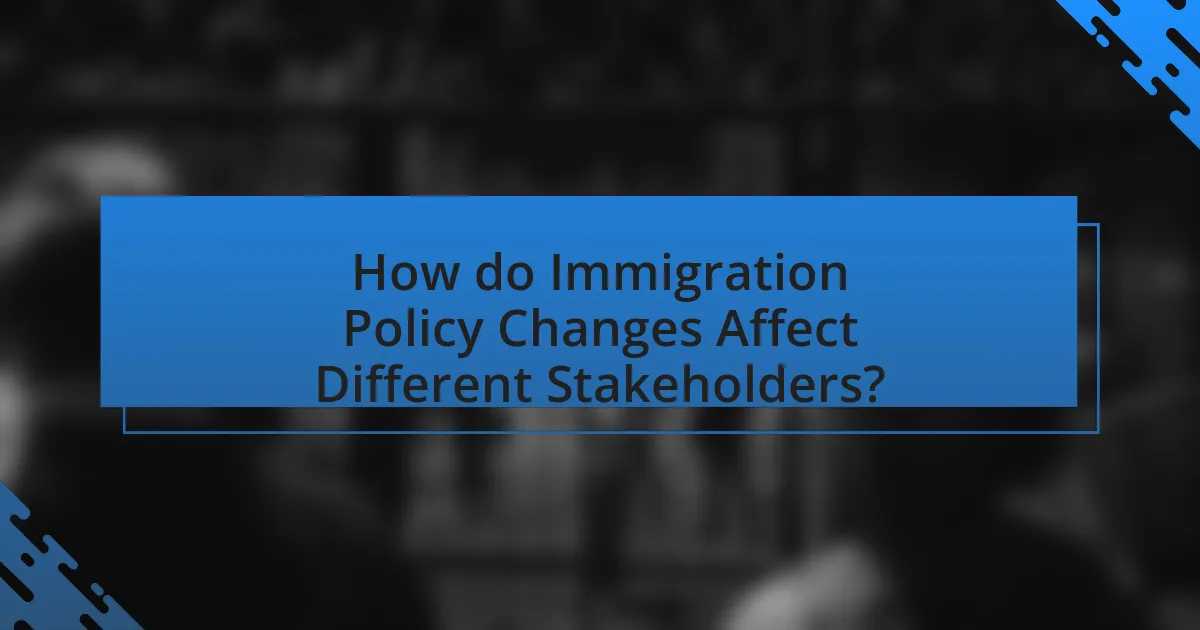
How do Immigration Policy Changes Affect Different Stakeholders?
Immigration policy changes significantly impact various stakeholders, including immigrants, employers, local communities, and government agencies. For immigrants, policy shifts can alter their legal status, access to work, and social services, affecting their ability to integrate and contribute to society. Employers may face labor shortages or increased costs due to changes in visa regulations, which can hinder business operations and economic growth. Local communities often experience demographic shifts, which can lead to both cultural enrichment and social tension, depending on the community’s receptiveness to newcomers. Government agencies must adapt to new regulations, which can strain resources and require adjustments in enforcement and support services. These dynamics illustrate the multifaceted effects of immigration policy changes on diverse stakeholders.
What are the impacts on immigrants and their communities?
Immigrants and their communities experience significant social, economic, and cultural impacts due to immigration policy changes. Socially, immigrants often face increased discrimination and xenophobia, which can lead to social isolation and mental health challenges. Economically, immigrants contribute to local economies by filling labor shortages, with studies showing that immigrants make up 17% of the U.S. workforce and contribute over $2 trillion to the economy. Culturally, immigrants enrich communities through diversity, bringing new perspectives and traditions, which can enhance social cohesion when supported by inclusive policies. These impacts highlight the complex interplay between immigration policies and the well-being of both immigrants and their communities.
How do policy changes affect the legal status of immigrants?
Policy changes can significantly alter the legal status of immigrants by either expanding or restricting their rights and pathways to residency or citizenship. For instance, the implementation of the Deferred Action for Childhood Arrivals (DACA) program in 2012 allowed certain undocumented immigrants who arrived as children to apply for work permits and defer deportation, thereby improving their legal status. Conversely, the 2017 travel ban imposed restrictions on individuals from specific countries, which negatively impacted the legal status of many immigrants by limiting their ability to enter the United States. These examples illustrate how shifts in policy can directly influence the legal standing of immigrant populations, affecting their access to legal protections and opportunities.
What are the social implications for immigrant communities?
The social implications for immigrant communities include challenges such as social integration, access to resources, and community cohesion. Immigrants often face barriers in assimilating into the host society, which can lead to social isolation and marginalization. For instance, studies show that immigrants may experience difficulties in accessing healthcare, education, and employment opportunities due to language barriers and discrimination. According to the Pew Research Center, immigrants are more likely to live in poverty compared to native-born citizens, which further exacerbates their social challenges. Additionally, the presence of immigrant communities can lead to cultural enrichment but may also result in tension with local populations, impacting social dynamics.
How do businesses respond to changes in immigration policy?
Businesses typically respond to changes in immigration policy by adjusting their hiring practices, workforce composition, and operational strategies. For instance, when immigration policies become more restrictive, companies may face labor shortages, particularly in industries reliant on immigrant labor, such as agriculture and hospitality. In response, businesses often increase wages or enhance benefits to attract domestic workers, as evidenced by a 2019 study from the National Bureau of Economic Research, which found that labor shortages due to immigration restrictions led to wage increases in affected sectors. Additionally, some businesses may invest in automation or technology to mitigate the impact of reduced labor availability, demonstrating a strategic shift in operational focus.
What economic effects do immigration policy changes have on businesses?
Immigration policy changes significantly impact businesses by altering labor supply and operational costs. When policies become more restrictive, businesses often face labor shortages, particularly in sectors reliant on immigrant workers, such as agriculture and hospitality. For instance, a study by the National Academies of Sciences, Engineering, and Medicine found that immigrants contribute to economic growth by filling essential roles that native workers may not occupy, thus enhancing productivity. Conversely, more lenient immigration policies can lead to an influx of workers, potentially lowering wages in certain industries but also increasing overall economic activity and consumer spending. Therefore, the economic effects of immigration policy changes on businesses are multifaceted, influencing labor availability, wage levels, and overall economic performance.
How do businesses advocate for or against immigration reforms?
Businesses advocate for or against immigration reforms through lobbying efforts, public statements, and participation in coalitions. For instance, organizations like the U.S. Chamber of Commerce actively lobby for policies that support immigration reform, emphasizing the economic benefits of a diverse workforce. Conversely, some businesses may oppose reforms that they believe could lead to labor shortages or increased operational costs, citing specific concerns about the impact on their industry. Evidence of this can be seen in various surveys, such as the 2021 National Association of Manufacturers report, which indicated that 70% of manufacturers support immigration reform to address workforce shortages.
What are the implications for law enforcement and public safety?
The implications for law enforcement and public safety in the context of immigration policy changes include increased challenges in community policing and resource allocation. Law enforcement agencies may face difficulties in building trust with immigrant communities, which can lead to underreporting of crimes and hinder investigations. For instance, studies have shown that when local police collaborate with immigration enforcement, immigrant communities are less likely to report crimes, fearing deportation or legal repercussions. This dynamic can exacerbate public safety issues, as criminals may exploit the fear of deportation among victims and witnesses. Additionally, changes in immigration policy can lead to shifts in crime patterns, requiring law enforcement to adapt their strategies and allocate resources effectively to address new challenges.
How do immigration policies influence law enforcement practices?
Immigration policies significantly influence law enforcement practices by dictating the priorities and methods used in policing and community engagement. For instance, policies that emphasize deportation and border security often lead law enforcement agencies to collaborate with federal immigration authorities, resulting in increased surveillance and enforcement actions against undocumented immigrants. A study by the American Civil Liberties Union (ACLU) highlights that jurisdictions adopting “sanctuary” policies, which limit cooperation with federal immigration enforcement, experience different law enforcement dynamics, focusing more on community safety rather than immigration status. This shift can lead to improved trust between immigrant communities and local police, ultimately affecting crime reporting and public safety outcomes.
What are the concerns regarding public safety and immigration enforcement?
Concerns regarding public safety and immigration enforcement primarily revolve around the potential for increased crime rates, community distrust, and the impact on local law enforcement. Studies indicate that aggressive immigration enforcement can lead to a chilling effect, where undocumented immigrants avoid reporting crimes or cooperating with police due to fear of deportation, thereby undermining public safety. For instance, a report by the American Civil Liberties Union highlights that in areas with strict immigration policies, crime reporting among immigrant communities declines significantly, which can hinder effective policing and community safety. Additionally, there are fears that immigration enforcement practices may disproportionately target minority communities, leading to racial profiling and civil rights violations, further exacerbating tensions between law enforcement and the public.
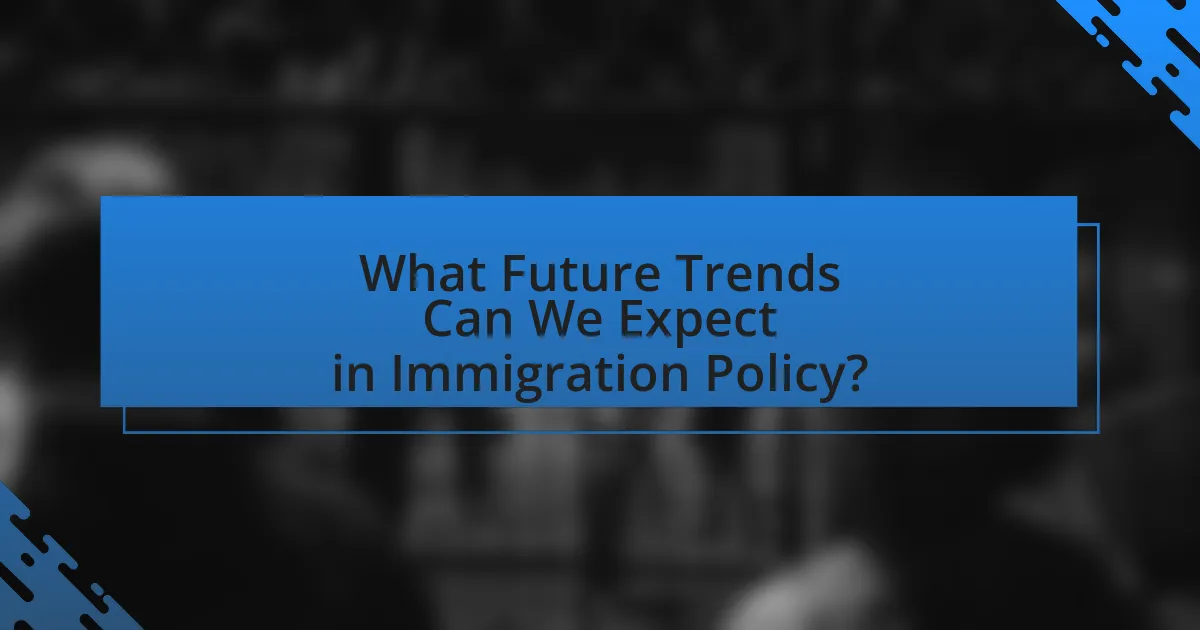
What Future Trends Can We Expect in Immigration Policy?
Future trends in immigration policy are likely to focus on increased regulation, technology integration, and humanitarian considerations. Governments are expected to implement stricter border controls and vetting processes to address security concerns, as evidenced by rising global tensions and migration crises. Additionally, the use of technology, such as biometric data and artificial intelligence, will enhance the efficiency of immigration systems, as seen in countries like Canada and Australia, which have already adopted such measures. Furthermore, there is a growing emphasis on humanitarian policies, reflecting a shift towards accommodating refugees and asylum seekers, driven by international agreements and public sentiment favoring human rights. These trends indicate a complex interplay between security, technology, and humanitarian needs in shaping future immigration policies.
How might upcoming elections influence immigration policy changes?
Upcoming elections can significantly influence immigration policy changes as political parties often campaign on specific immigration platforms that reflect their ideologies. For instance, candidates may propose stricter immigration controls or pathways to citizenship, depending on their voter base’s preferences. Historical data shows that shifts in congressional majorities after elections have led to substantial changes in immigration laws, such as the Immigration Reform and Control Act of 1986, which was influenced by the political climate of that time. Additionally, public opinion during election cycles can pressure elected officials to adopt more favorable or restrictive immigration policies, as seen in the 2016 U.S. presidential election, where immigration became a central issue.
What are the key issues candidates are focusing on regarding immigration?
Candidates are focusing on several key issues regarding immigration, including border security, pathways to citizenship, and the impact of immigration on the economy. Border security remains a top priority, with candidates advocating for increased funding for border patrol and technology to prevent illegal crossings. Pathways to citizenship for undocumented immigrants is another significant issue, with many candidates proposing reforms to allow long-term residents to gain legal status. Additionally, candidates are addressing the economic implications of immigration, emphasizing both the contributions of immigrants to the labor force and the need for policies that support job creation for all citizens. These issues reflect the broader political ramifications of immigration policy changes, as they influence voter sentiment and party platforms.
How do electoral outcomes shape immigration policy directions?
Electoral outcomes significantly influence immigration policy directions by determining which political party or coalition gains power and sets the legislative agenda. For instance, when a party that advocates for stricter immigration controls wins elections, policies often shift towards increased border security and reduced immigration quotas, as seen during the Trump administration from 2017 to 2021, which implemented measures like the travel ban and family separation policies. Conversely, when parties favoring more inclusive immigration policies, such as the Biden administration, take office, there is typically a move towards reforming immigration laws to provide pathways to citizenship and protect undocumented immigrants. Historical data shows that changes in congressional majorities also impact immigration legislation, with significant reforms occurring during periods of unified government, such as the Immigration Reform and Control Act of 1986, which was passed when Democrats controlled both the presidency and Congress.
What role does international relations play in shaping immigration policies?
International relations significantly influence immigration policies by establishing diplomatic agreements and frameworks that govern the movement of people across borders. For instance, treaties such as the Schengen Agreement in Europe facilitate free movement among member states, directly impacting national immigration policies. Additionally, bilateral agreements between countries, like the U.S.-Mexico agreements on border security and labor migration, shape how each nation approaches immigration. These international interactions often reflect broader geopolitical considerations, such as economic partnerships and security concerns, which further dictate the terms and conditions of immigration policies.
How do global events impact national immigration policies?
Global events significantly influence national immigration policies by prompting governments to adapt their regulations in response to crises, economic shifts, or geopolitical changes. For instance, the Syrian civil war led many countries to implement more lenient asylum policies to accommodate refugees, as seen in Germany’s decision to accept over one million asylum seekers in 2015. Additionally, economic downturns, such as the 2008 financial crisis, often result in stricter immigration controls as nations prioritize job security for their citizens. These adaptations reflect the direct correlation between global circumstances and the legislative actions taken by individual countries to manage immigration effectively.
What are the implications of international agreements on immigration?
International agreements on immigration significantly influence national policies and practices regarding the movement of people across borders. These agreements often establish frameworks for cooperation among countries, leading to harmonized immigration laws, shared responsibilities for border security, and enhanced protections for migrants. For instance, the 1951 Refugee Convention and its 1967 Protocol obligate signatory states to protect refugees, thereby shaping domestic asylum policies. Additionally, agreements like the Schengen Agreement facilitate free movement within Europe, impacting immigration controls and visa regulations among member states. Such international frameworks can also lead to increased scrutiny of immigration enforcement practices and promote human rights standards, ultimately affecting how countries manage immigration and respond to migrant crises.
What best practices can policymakers adopt for effective immigration reform?
Policymakers can adopt data-driven approaches, stakeholder engagement, and comprehensive policy frameworks for effective immigration reform. Data-driven approaches involve utilizing empirical evidence to inform policy decisions, ensuring that reforms address actual needs and challenges within the immigration system. For instance, studies from the Migration Policy Institute indicate that understanding demographic trends and labor market demands can lead to more effective immigration policies.
Stakeholder engagement is crucial, as involving community organizations, businesses, and immigrant groups in the policymaking process fosters trust and ensures that diverse perspectives are considered. Research from the American Immigration Council highlights that inclusive dialogue can lead to more equitable and effective reforms.
Lastly, comprehensive policy frameworks that address various aspects of immigration—such as pathways to citizenship, border security, and integration programs—are essential. The National Academies of Sciences, Engineering, and Medicine report emphasizes that holistic approaches can enhance the effectiveness of immigration systems and promote social cohesion.
How can stakeholder engagement improve immigration policy outcomes?
Stakeholder engagement can improve immigration policy outcomes by fostering collaboration and ensuring that diverse perspectives are considered in the policymaking process. Engaging stakeholders, such as community organizations, businesses, and immigrant advocacy groups, allows policymakers to gather valuable insights and data on the real-world impacts of immigration policies. For instance, research by the Migration Policy Institute indicates that inclusive stakeholder engagement leads to more effective policies that address the needs of both immigrants and the communities they join, ultimately resulting in better integration and social cohesion. This collaborative approach not only enhances the legitimacy of the policies but also increases public support and compliance, as stakeholders feel their voices are heard and their concerns are addressed.
What lessons can be learned from past immigration policy changes?
Past immigration policy changes reveal that policies must balance national security with humanitarian considerations. For instance, the Immigration and Nationality Act of 1965 shifted U.S. immigration from a quota system based on national origin to a preference system based on family reunification and skills, leading to increased immigration from Asia and Latin America. This change demonstrated that policies can significantly reshape demographic trends and influence social integration. Additionally, the backlash against the Deferred Action for Childhood Arrivals (DACA) program highlighted the political volatility surrounding immigration reforms, showing that policies can provoke strong public and political reactions. These examples underscore the importance of considering both immediate political implications and long-term societal impacts when crafting immigration policies.

